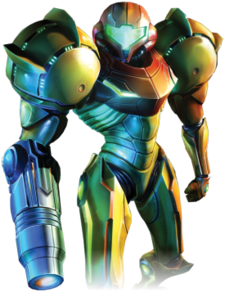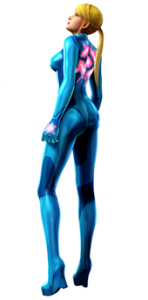by Kristin Bezio
When Keidra asked me to think about an “iconic woman” in videogames, I immediately and naturally thought of Lara Croft of the Tomb Raider series. And then it occurred to me that there is a powerful female icon in the gaming world that is older than Croft, scarier than Croft, and whom I would bet on winning in a fight with Croft – Samus Aran of the Metroid series.

What is most intriguing about Samus Aran from my perspective is not only her longevity, but the spontaneity of her creation. The character, the narrative line, and the concept of the original Metroid were all established by the time one of the staff suddenly remarked, according to an anecdote by Yoshio Sakamoto, “Hey, wouldn’t that be kind of cool if it turned out that this person inside the suit was a woman?” (Harris, 2004).
That sudden decision to turn the gender-neutral “person” (let’s be honest, when there is no stated gender, pretty much everyone assumes that a character is male, especially if said character is in full armor and shoots things) into a woman is one of the reasons that Samus Aran is so iconographic as a female videogame protagonist. Other than The Other M, the Metroid games deliberately avoid sexualizing Samus. Sakamoto specifically explains that although in the later games there is an attempt to “express her femininity a little more,” there is also a concerted effort to do so “without trying to turn her into a sex object” (Harris, 2004).
Unlike most female characters, Samus was not designed to be “a sex object,” she was designed to be a space 
The very fact that Samus’s gender shocked the original audience of Metroid is part of what makes her a fantastic example of a feminist icon within videogames; she was a great character even before players knew she was a woman. Unlike, for instance, the original Lara Croft, Samus’s appeal came from her context and gameplay, her role within the narrative rather than the size of her cleavage.
And then came The Other M. First of all, the game includes a new suit for Samus, one that doesn’t obscure the 
To put it bluntly, Metroid: Other M is a story that consistently portrays an abusive relationship between two of its main characters, and romanticizes it, painting the depicted behavior as justifiable, even laudable. No single moment in the game bears the blame for this (though a couple are problematic on their own); the entire story, taken as a whole, is the problem. (MenTaLguY, 2010)
The Other M essentially takes a powerful icon of feminine autonomy and makes her into an abused damsel, completely stripping her of the very characteristics that made her both powerful and attractive to players to begin with.
However, even taking The Other M into consideration (and that is the most recent release in the series), Samus Aran as she was originally conceived continues to represent what I consider to be the ideal female protagonist in a shooter or combat-based game. She’s independent, powerful, and – most importantly – her gender is irrelevant to her abilities and her successes. She doesn’t use sex to succeed and the game doesn’t flaunt her physicality as a way to entice players. She’s a badass protagonist irrespective of the fact that she’s a woman, and the fact that she’s all these things first and a woman second makes her an ideal example of what developers should strive for in their female characters.


[…] Over on TLF, the theme for March is “Women in Media,” and in honor of the theme I put together my thoughts on the “iconic woman” in videogames. There are any number of significant women in the industry, but I wanted to focus instead on the women in the games, and went with Samus Aran, hero of the Metroid series since 1986. […]